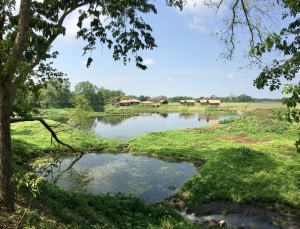
We sailed to the world’s largest river island, Majuli, in the mighty river Brahmaputra and cycled in stunning Assamese countryside to tribal areas and 500 year old Hindu monasteries …
Sivasagar to Nimati to Majuli island | Assam | North East India
From Sivasagar we took a minibus called a Traveller on the highway for one and half hours, towards Jorhat, that cost 70 rupees (£0.6). Included in the price is a certain intimacy with local people. I think they could advertise the Traveller minibuses as,
“Come and get close to real Assamese people, speak to them, become friends and sit with them shoulder to shoulder, buttock to buttock for that real off-the-beaten-track experience“
The minibus stops frequently to pick people up anywhere and they reminded me of my commute when I lived in Rwanda.
After 90 minutes, the conductor, a small lad with a big voice, told us we had arrived at the village of Nimati just outside Jorhat and to get to the ferry, for the island of Majuli, we’d need to take an auto-rickshaw (oto riksa) to Nimati Ghat, the ferry terminal.
It was a quiet cross-roads on the National Highway 3, a few paan stalls and shop fronts dripping with multicoloured chains of Lays crisp packets; I stopped haggling with the auto rickshaw driver when I realised this was a sellers’ market. He didn’t look desperate for the fare (Assamese people normally don’t) and we didn’t have a ride, so we paid 200 rupees (£2.2) for a 25 minute ride to the banks of the River Brahmaputra (with an off-licence stop included).
The driver, Papu, was a pleasant guy who was very curious about us. How could I speak Assamese? Where were we from and was Sarah a foreigner? Many people we’ve met on the road have a genuine curiosity towards foreigners.
Assam, where foreigners are fascinating and exotic
In the west, the word foreigner usually has connotations of people ‘taking our jobs, drinking our beer’ and in the worst cases prefixed with ‘bloody’. Many problems are unfairly attributed by the right to foreigners; overcrowded buses; a creaking health service; crime; and a lack of bland-food restaurants.
In Assam, the word foreigner is used objectively without connotations of derision, belittling or alienation; it carries with it a genuine air of curosity and fascination.
“It doesn’t matter that you’re a database administrator or an accountant back home, it doesn’t matter that your hobby is watching Come Dine with Me on Dave; here in Assam foreign tourists are interesting. You’re exotic. You are snap-worthy. It’s kinda awkward.“
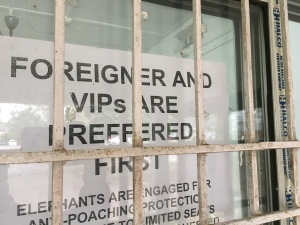
For many years, and as recently as the mid 1990s, foreigners were not allowed in to India’s north east region. It was called a ‘restricted area’ and tourists would have to apply for a special permit to enter because of the region’s strategic location next to Myanmar, China, Bangladesh and Bhutan.
Although restrictions have now been lifted for most parts of the north east, even today there are very few overseas tourists that visit and even domestic tourists consider the north east of India to be an adventurous destination.
As a general rule, tourists in Assam don’t get the hassle they often get in other places like Agra, Jaipur or Delhi. No one comes up to you in the street and says, ‘what country?’. There aren’t any scams or cons, hawkers or people pretending to be tour guides; there is no Assamese desperation to sell anything to you, the seller are just too laid back and understated.
There is though, a certain stare of curiosity (in India, staring is not considered rude) because if you’ve never seen a westerner before it really is a unique sight. But the Assamese are easy to befriend, all it takes is a quick ‘hi!’ or ‘Bhaal ne?’ (how’s it going?) then just watch that Colgate smile come out.
The ferry to Majuli island across the Brahmaputra River
Okay, where were we? To get to the island of Majuli there’s a 45 minute ferry ride from Nimati Ghat, which is a collection of shops, a small wooden ticket booth and a muddy slope down to the water’s edge.
The ferry ride is relaxed; it glides through the expansive Brahmaputra, little eddies and whirlpools swirl and clumps of water-hyacinth float by on its powerful current as if on a grey silt-water conveyor belt.
On one of the great rivers of the world, the Brahmaputra
The Brahmaputra is truly one of the great rivers of the world. Over 1,800 miles long with an average depth of 125 feet and average width of 6 miles, it starts in a holy lake in Tibet called Mansorovar; it widens in the Assam valley to achieve a sea-like grandness and winds its course west and south to meet the Ganges and the Padma to form the world’s biggest delta before entering the the Bay of Bengal.

It carries an air of majesty, calmness and brutal, destructive power, tinged with an air of mystery (its full course was only discovered in the 1880s).
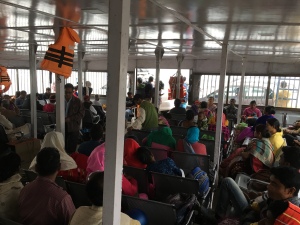
Only the lack of life-jackets stressed me out; there were 100 passengers and 15 lifejackets. The ratio troubled me. The Brahmaputra is too wide, its current too strong to swim in; I grappled with the ethics of wrestling an old granny for the last life-jacket as the ship slowly sank.
After 45 minutes and some red tea (lal sa) we arrived at Kamalabari Ferry point in Majuli, the world’s largest river island.
***
We took a brief Traveller ride (everything is close on the island) through the two main towns, Kamalabari and Garamur, and managed to get lost on our walk to the hotel because of a problem with the map on the hotel app.
Soon we had our own entourage of five stray dogs, making cute eyes and pining and sniffing us. These strays are clever – they never follow locals, just backpackers because they are most likely to give them food.
A thunderstorm came in,there was a power cut and so we sat on the hotel room watching lightning crack the clouds and the fireflies switch on and off like green shooting stars, supping warm beer from cans we had smuggled in from Nimati, because the island is tea-total.
***
Cycling to the monasteries
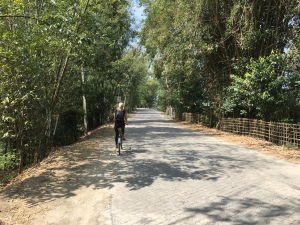
Cycling is a great option to really explore Majuli and the next morning the hotel lent us two robust, single-gear Hero bicycles built for comfort and durability rather than speed.
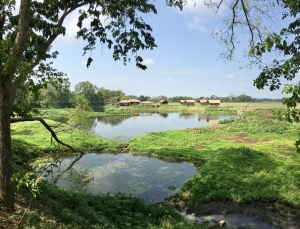
Soon we were cycling past picturesque scenery, waving back at people, through rustic village scenes untouched by modernity; lakes; fields of cows; bamboo groves; tribal thatched huts on stilts; women weaving on looms; groups going out to fish and men working in paddy fields. Because Majuli is an island and harder to get to, it’s unspoilt beauty has remained intact, and it’s the most litter-free place I have visited in India.

The roads on Majuli centre on two crossroads at Kamalabari in the south and 4 kilometres to its north at Garamur; at 9am we cycled south to the monastery at Uttar Kamalbari.

The island is a home to 16th century Vishnu monasteries called satras but pronounced xotro. They are living monasteries where hundreds of monks spend practically all their lives praying, reading scripture, doing cultural events and chanting. The monasteries of Majuli were set up by Assam’s social reformer and saint, Sankardeva and his disciple Mahadeva.
We parked our bikes and heard the distant sound of chanting, cymbals and drums from a prayer hall (naam ghar) behind some swaying coconut palms. We sat with a few of the monks for a while and then walked through the monk’s quarters of light-blue wattle-and-daub lodgings.
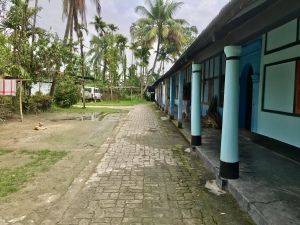
Occasionally a monk would come out, his black hair flowing down his back, wearing a cotton dhoti, many with handsome features, angular jaw-lines, sharp noses and almond-shaped, Assamese eyes.
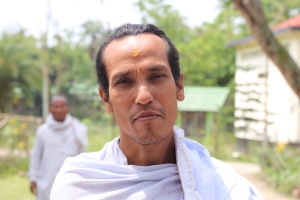 Photo by http://www.sarahwillsphotography.com
Photo by http://www.sarahwillsphotography.com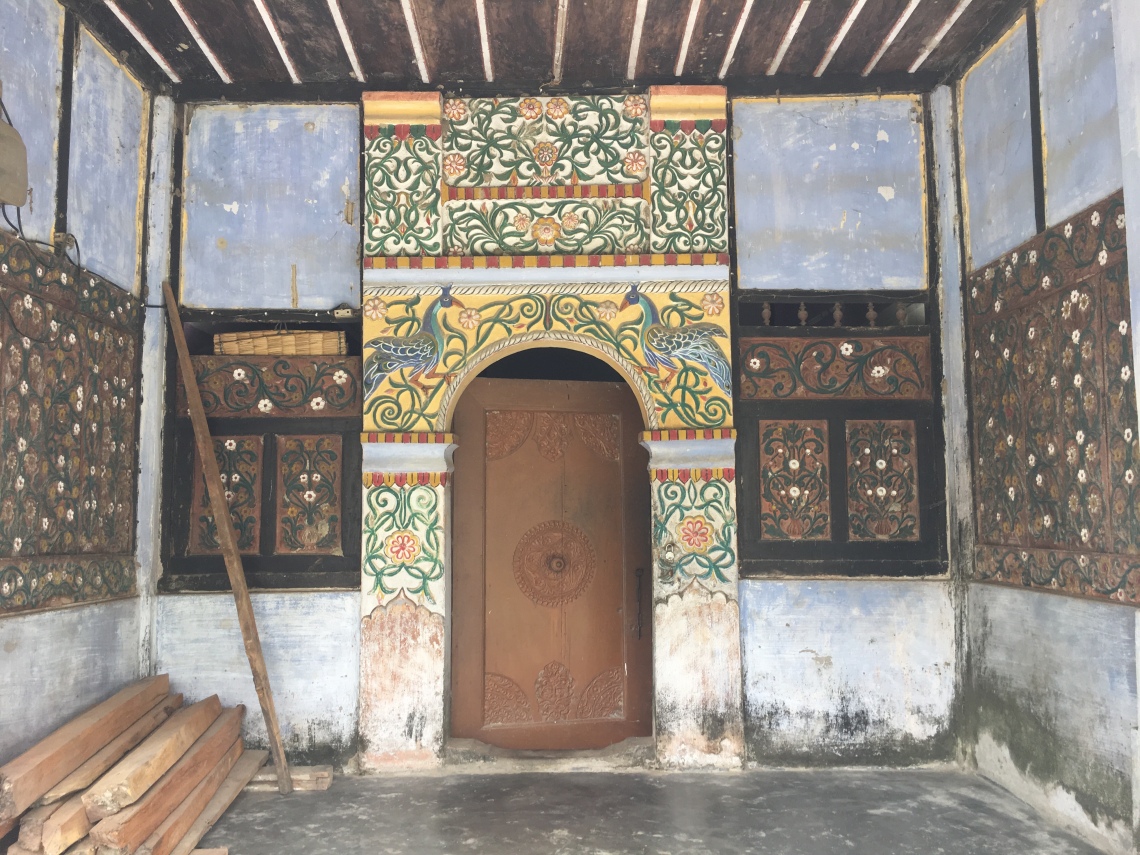
My friend Nitul, the monk
We cycled to Auniati Satra through 5 kilometres of bamboo groves and fields of electric green on either side. We removed our shoes and socks and walked down the entrance to the satra which also has a museum and a lake, and apart from birdsong, has a tranquil silence despite being the home for 350 monks (bhakats).

I met Nitul Dutta 12 years ago when I first visited Majuli and we always stayed in touch. We sat in a tea-shop and chatted. Nitul looked fresh-faced despite a monk’s day starting every day at 4am, in the silence before dawn, when even birds are asleep, when they meditate and chant omm, the ancient Hindu mantra, said to be the frequency of the universe.

There are three types of monastery, he explains; celibate (where the monks cannot marry); mask-making ones where they can marry; and mixed ones where the monks can marry but not the head of the monastery, the guru.
Auniati Satra is a celibate monastery, and Nitul who was born on the island is one of seven siblings, came to the monastery as a 7 seven year old.
“Here boys come as young as between 5 and 10. Some big families are poor, so they come to the monastery to meet the guru so that he might be able to look after the boy.”
Nitul manages communications and external relations for the monastery and is a qualified tour guide, organising stays for big groups. In a store room he keeps 500 life-jackets entrusted to him by a large tour operator to be used only for their tourists crossing the river. I felt a little envious.
The cowherd and the Missing village
Nitul waved us off. “Next time, you come at full moon in November.” he said. “There are new costumes and masks for the festival of raas lila, and 5 days of non-stop chanting.”
We cycled away toward Kamalabari and after one kilometre, Sarah’s cycle chain came loose. I tried to hook it over the rear cog but the chain guard got in the way. A young lad in a nearby field came over and managed to fix it by removing the chain off both cogs and attaching it first to the back cog.
He was a cowherd and took us to see his cows in a nearby field; he warned us not to get too close, ‘koosibo pare,’ he said (it might gore you).
When I asked him if he got many foreigners visiting round his village he replied a few years ago some came to drink Missing rice beer.

At sunset we cycled around the muddy trackways north of Garamur to villages of the Missing tribe who live in thatched huts on stilts. Children of distinctly oriental appearance waved at us as we passed as their mothers woven on looms between stilts under their houses.
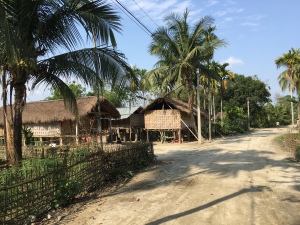
40% of the island belong to this tribe which originated from the state to the north of Assam, Arunachal Pradesh. which borders China; they speak Assamese as well as their native tongue of Missing and they are animist, worshipping sun and moon gods.
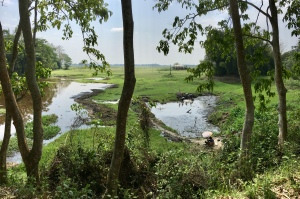
Too soon it was time to leave, but at the end of day, after a 24 kilometres cycle ride, I was grateful that I wasn’t saddle-sore as we boarded the taxi to the ferry point. Those comfy saddles on those single gear bikes had their benefits.
***
‘Things to See in Majuli’ was first published on http://www.heyloons.com.
This post is part of the blog series called ’90 Days in South East Asia’
***
Some useful things to know if you’re thinking about visiting Majuli

- How to get to the there: The nearest airport is Jorhat, then take a taxi to the ferry point Nimati Ghat and a 45 minute ferry ride to Majuli. Alternatively you can hire a car or motorbike to take on to the ferry.
- Best time to visit: Full moon in November. The weather is sunny and there is the Rasa Lila festival depicting Krishna and the gopis. The monasteries put on plays and dramas and have five days of non-stop chanting.
- What to do: Visit the monasteries, religious plays, see rural Assamese life, mask- making, cycle country paths and explore, visit a tribal village (just cycle by and say hi) and most of all … just relax.
- How to get around: Cycle. The island is small and it’s easy to cycle around and you can explore country paths. Many of the roads have now become paved making it much easier than sand to cycle on. There are also taxis that can take you around.
- Where to stay: There are comfortable built-up hotels now on Majuli. There is also the option to stay in tribal thatched huts on stilts, made from bamboo cane.
- Useful tips:
Always remove your shoes and socks when entering the grounds of a monastery.
The island is tea-total so don’t expect to buy beer (but you can buy tribal rice beer). - There is good phone signal and 4G in the town areas.
- From Kamalabari ghat ferry terminal, taking a shared minibus to the main towns costs a lot less than taking the jeeps that will approach you.
***
All the links to blog posts in the series are as follows:
1) I’m backpacking around Southeast Asia for 90 days
2) Packing for backpacking: 16 useful things to take on your travels
3) How to sleep on a flight (aches on a plane)
5) A storm in an Assamese teacup
6) On the lazy man’s road: the story of Dhodar Ali
7) Digboi, the oil town in the rainforest
8) To Sivasagar: home of the Assamese kings
9) Things to see in Majuli, the world’s largest river island
10) An unexpected treat on the river Brahmaputra
11) Helpful hints on how to climb a 17 foot elephant on your wedding day
13) The Assamese Bihu: a time of unbridled joy
14) A tale of a dry day in India
15) Kalimpong and a magical Himalayan wedding
16) Chiang Mai, a pretty little temple town
17) Replanning our route, re-routing our plan
18) Luang Prabang in Laos: the jewel on the Mekong River
19) A slow and unintended minibus to Vang Vieng
20) In the laid-back city of Vientiane
21) Laos: Caves, a jungle trek and the mysterious turquoise lake
22) On our way down south in Laos
24) Friday night at the Saigon Opera House
26) Vietnam days: Hoi An, Hue and Hanoi
27) Landing in the sea at Halong Bay, Vietnam
29) Bagan, the jewel of Myanmar
30) Three nights on Lake Inle in Myanmar
31) Finding a perfect perfume in Singapore
32) In Borneo, watching the orangutans at play
33) Watching turtles at Selingan Island
***
Those ponds in Majuli are so beautiful.
LikeLiked by 1 person
Yes they really are. It’s quite unspoilt being a river island that’s hard to get to. There’s been talk of building a bridge to the island which would change it irrevocably. I hope that doesn’t happen.
LikeLiked by 1 person
I suspect it helps to be able to speak Assamese in a place like that…
LikeLiked by 1 person
It does indeed Dave. Alternatively a local guide is going to be very useful.
LikeLiked by 1 person